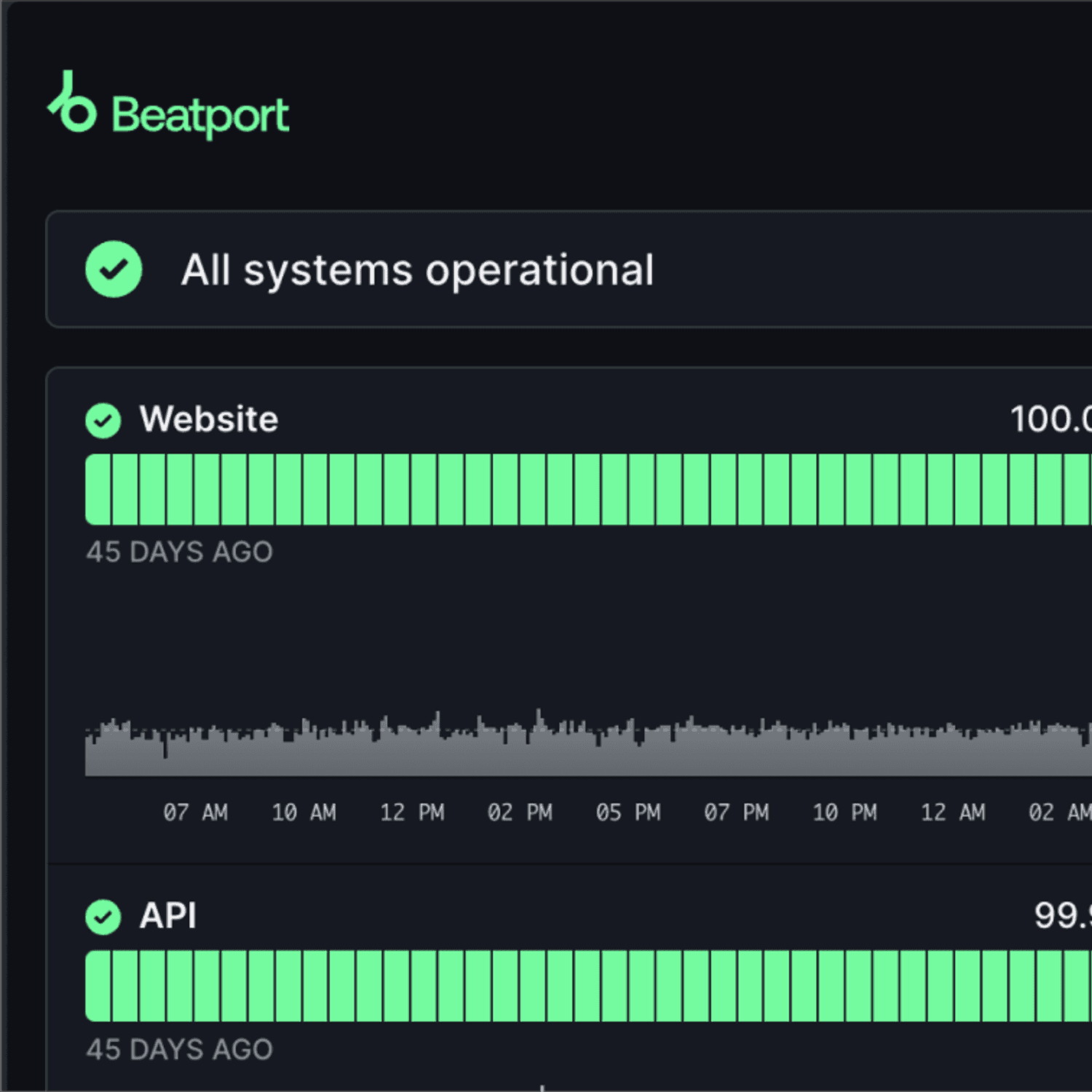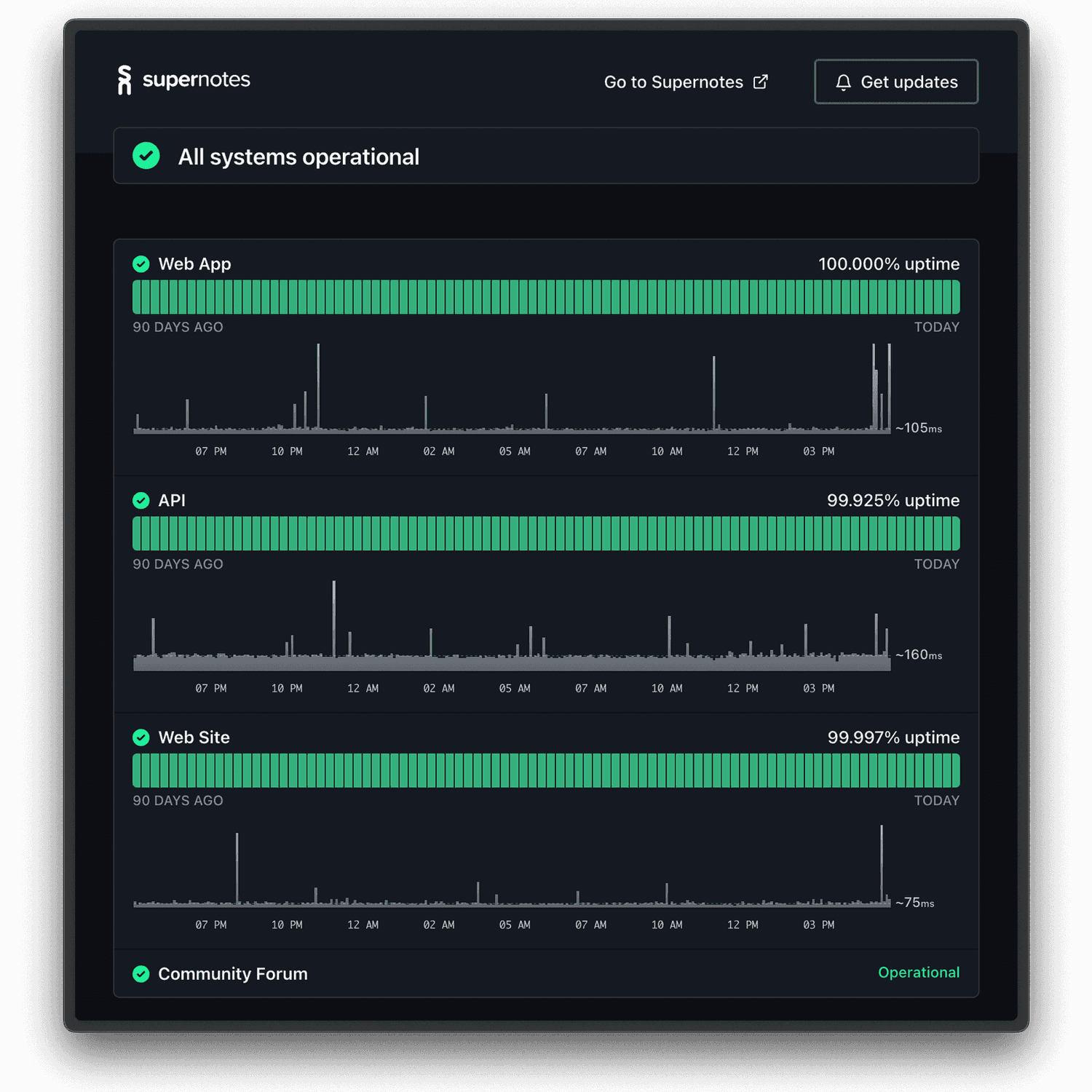If you work as a CTO, then you already know that having robust monitoring and analytical tools for your technology stack is a prerequisite to getting your job done right.
Many companies that started off using Datadog discovered that it can become prohibitively expensive and complex when they needed to scale. As such, there are a lot of people out there currently seeking out alternatives.
Today, we will review the top monitoring and reporting alternatives to Datadog (including Hyperping!) to help you choose the best option. We’ll be covering everything from features to pricing, so you can fast-track the decision-making process and get back to improving your software.
What Is Datadog?
Datadog provides performance and security monitoring solutions that can see inside any tech stack or any app at any scale.
This includes every aspect of infrastructure monitoring, log management, APM, and security monitoring and testing, through to cloud-based services and IoT monitoring.
Why Are Monitoring Tools Important?
They Demonstrate Your Brand’s Reliability
Minimizing downtime through the deployment of the right monitoring tools goes a long way to reassuring your users that they can depend on your products and services.
A good reputation is hard won and easily lost.
Even a single downtime event can lead to catastrophic results, and given most outages are still caused by breakage of infrastructure or software, tools that can prevent or mitigate downtime caused by problems in software or infrastructure are increasingly vital.
They Help to Reduce Costs
Uptime monitoring tools don’t only help to avoid the costs of losing customers, but they also help businesses avoid incurring the tremendous additional costs that accompany any system outage.
It has been calculated that an outage costs small to medium-sized businesses (SMBs) between $8,000 and $25,000 every hour. At the enterprise level, 91% of those surveyed said that hourly costs of downtime exceeded $300,000.
Having the right tools in place to avoid instances that result in such significant revenue losses has to be a top priority for any organization.
They Identify the Root Cause of the Error
You can’t fix a problem until you identify the cause.
Uptime monitoring for your website not only identifies when there is a problem and alerts you to the fact, but they also provide the means to locate the root cause of any issue, allowing for prompt and effective resolution of the issue(s).
Criteria to Consider When Choosing Uptime Monitoring Tools
The Right Features
With the abundance of monitoring and reporting tools currently available, you must source one which meets your specific requirements.
For example, you don’t want to invest in a tool that specializes in application performance monitoring if you don’t have many (or any) in-house apps to monitor.
This may appear self-evident, but many contemporary tools sell themselves as an all-in-one tool for performance monitoring only to come up wanting, be it in infrastructure monitoring, or log management—you can pick your poison here.
Robust Alert System
Any monitoring and reporting solution worth its salt is going to have comprehensive alert and notification capabilities.
It is imperative with tools such as these that all vital communications occur in a timely and efficient fashion.
This means that the tools must be configurable to very niche requirements to ensure every user and stakeholder gets the information they need in an actionable timeframe.
Comprehensive Reporting
The alerts and notifications are a vital aspect of these tools, but their use would be extremely limited if that’s all they did.
The more in-depth and granular the reporting capabilities, the better a tool will be at identifying where and why problems occur.
Top 4 Datadog Alternatives
- 1. Hyperping: The best choice for startups and SMBs
- 2. Site24x7: The best choice for mid-large scale organizations
- 3. AppDynamics: The best choice for global IT/Telcos and businesses with app-rich infrastructure
- 4. Cronitor: The best choice for cron jobs
1. Hyperping
Hyperping delivers uptime monitoring for websites and APIs as well as providing hosted status pages with in-built monitoring capabilities under your domain.
These all come with robust alerts and notifications that can be delivered across numerous channels including SMS, email, Slack Channels, Telegram, Discord, and much more.
Features
- Instant Alerts: Never miss out on a single instance of downtime with instant alerts across multiple channels.

- Status Pages: Keep all your users up to date at all times with customized status pages that do not rely on third-party integrations.

- Browsers Checks: Complete end-to-end scenario automation based on the Puppeteer & Playwright framework.

Pricing
Hyperping has a free-to-use version that allows for 5 monitors and one status page. It’s great to get a feel for how the tool works, but will likely be insufficient for most businesses.
There are four paid licensing options.
Hobby is $14/month and for that, you get up to 15 monitors, 1 status page, and 1 browser check.
Startup is the next package, priced at $29/month for which you get 50 monitors, 1 status page, 3 browser checks, and 1 teammate.
Pro costs $89/month—for this you receive 100 monitors, unlimited status pages, 10 browser checks, and 5 teammates.
Business will set you back $199/month for which you get unlimited monitors, unlimited status pages, 25 browser checks, 15 teammates, and an infinite number of subscribers and incidents.

Pros and cons
Pros
- Incredibly easy to use
- Real-time, multichannel alerts
- Good value for money
- Detailed incident history
Cons
- Does not allow for true observability
- Relatively new tool
2. Site24x7
Site24x7 from Manage Engine is a total stack monitoring solution for Web, APM, server, network, cloud, and real-user monitoring and reporting that is used by some of the largest tech companies including Juniper, SAP, and VMWare.
Features
- Real User Monitoring: Measure the real experience of your web users and native mobile app users and analyze key metrics segmented by browsers, platform, geography, ISP, and more to fine-tune performance.

- Cloud Monitoring: Site24x7 offers a comprehensive insight across multiple public cloud providers including AWS, Microsoft Azure, GCP, and on-premises data centers powered using virtualization and Hyper-converged infrastructure (HCI) technology like VMware and Nutanix.

- Log Management: Site24x7’s log management aggregates Syslogs, application logs, and log data from text files from hundreds of VMs and application services. You can run interactive search analysis and configure thresholds based on conditions or values to get alerted.
Pricing
There is no free version or free trial for Site24x7.
The Starter license costs $9/month and offers 10 basic monitors. The Pro plan gives you 40 monitors for $35/month, while the Classic plan gives you 100 monitors for $89/month.
Enterprise plans are all bespoke, with prices starting at $255/month.

Pros and cons
Pros
- Works well on desktop or mobile
- Good for security monitoring
- Certificate monitoring
- Global datacenter monitoring
Cons
- Advanced monitors are expensive
- Analysis reports can be somewhat lacking
- Users report delays in receiving notifications
3. AppDynamics
AppDynamics from Cisco is a leading platform for application and mob app monitoring that comes with application mapping and predictive capabilities as part of its core toolset.
Features
- Serverless Monitoring: AppDynamics leverages highly scalable serverless application functions to deliver a flawless user experience. You gain full visibility from the end-user to back-end application performance in a single, unified observability platform.

- Microservices Monitoring: Allows you to measure business transaction health across relevant microservices and containers like Amazon Web Services to achieve greater operational and organizational efficiency.

- Cloud Migration: Make your transition to the cloud a seamless and painless task, with an end-to-end view of every application and hybrid cloud infrastructure element critical to your business infrastructure.

Pricing
AppDynamics is sold in packages that are licensed per CPU core.
A CPU core is defined as the logical thread core or processor reported by the operating system on a unique instance of a physical or virtual host machine.
The typical starting price at the base level of packages is approximately $3,300 per year. However, the final costs could run to many multiples of that figure depending on your requirements.
Pros and cons
Pros
- An industry-leading app intelligence platform
- Good customizations
- Top-notch root cause issue identification
Cons
- Expensive
- Requires top-level technical expertise to deploy, configure and maintain
- Licenses can become complex and incur additional, unanticipated costs
4. Cronitor
Cronitor was originally built to help better manage cron jobs and uptime but has evolved into a complete monitoring health check solution that includes its own, built-in status pages and four other key monitoring tools.
Features
- Heartbeats: Cronitor’s heartbeats allow you to monitor any software component from hosts to webhooks and devices and receive status updates on everything in real-time.

- Real User Monitoring (RUM): Cronitor's RUM measures performance metrics like page load time and core web vitals. It provides real-time insights to improve website performance.

- Uptime Monitoring: Gives instant downtime alerts and detailed analytics from twelve global locations with customizable reporting options allowing you to monitor the way that works best for your team and your business.

Pricing
Cronitor’s free Hacker version allows for 5 monitors and basic alerts (but lacks premium features, as one might expect).
Their paid versions are limited to two tiers.
The Business plan charges $2/month per monitor + $5/month per user (which is a nice, simple pricing structure).
Enterprise-level licensing is bespoke and available on request.

Pros and cons
Pros
- Easy to set up and simple UI makes it easy to deploy and get to grips with
- Strong performance monitoring and reporting
- Customizable alerts are very handy
Cons
- Enterprise-level plan can be expensive relative to the business plan for what you get
- Lacks documentation and education resources for more complex requirements
- Some integrations can be buggy and remain unaddressed
Get More From Your Monitoring Tool With Hyperping
When it comes to uptime monitoring and reporting, Hyperping is your go-to tool. Look no further for top-notch functionality and reliability.
With Hyperping you get comprehensive monitoring capabilities like 30-second monitoring, end-to-end testing on the Puppet & Playwright framework, SSL reporting, and much more—all packaged with beautiful, interactive status pages.
Get started with a 15-day free trial and see what Hyperping can do!


